
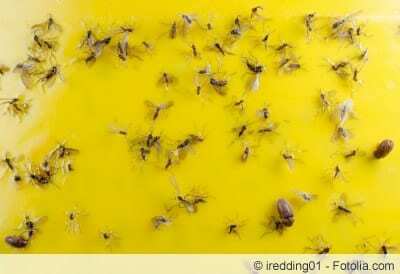
Table of contents
- recognize fungus gnats
- Flying fungus gnats are not a problem
- Get rid of flying fungus gnats
- Better not
- Where do the fungus gnats come from?
Fungus gnats can become a problem if you inadvertently but effectively act as a 'fungus gnat breeder'. The article tells you how to prevent this. Fungus gnats are annoying but won't harm your plants or you in any way unless they mass reproduce. You can stop this with simple home remedies and prevent it permanently with similarly simple means:
recognize fungus gnats
If small black dots suddenly appear in front of your eyes and move - hopefully this is not due to the previous night of partying, and you do not have to go to the ophthalmologist as soon as possible. If you have houseplants, only one generation of fungus gnats will have just hatched.
The dark color has given the mini mosquitoes the rather sad name, but it seems that not particularly disturbing - the lively dancing around is absolutely characteristic of the fungus gnats; if you see something like that, it's fungus gnats. Thank God only fungus gnats, the little planes do no harm and are easy to recognize by their zigzag flight and can be decimated easily and well, there are many more persistent and difficult to identify Houseplant Pests.
“Only” fungus gnats? The air is black and the mini planes are somehow pretty gross? Yes, because when you recognize fungus gnats by their prancing flight, you see adult fungus gnats (imagines). The adult fungus gnats live just five days to a week. During this time they do nothing to your plants, zero, because they never eat, but live on the nutrient reserves of their larval period. Maybe they sip a micro drop of water, but actually mature fungus gnats live only for one purpose: to mate throughout their lives in order to reproduce (actually neither bad).
Flying fungus gnats are not a problem
As I said, flying fungus gnats want nothing more than to make love, and they only have a few days anyway – with that in mind, you could just let the fungus gnats do their thing until the problem soon takes care of itself has.
The problem, however, is not initially the fungus gnats themselves, but possible visits from people who are more distant from nature (supervisors, mothers-in-law, etc.) whose expressions you can clearly read how they feel about you having “bugs in your apartment breed".
In addition, the life goal of reproduction is a problem for adult fungus gnats: If you let the fungus gnats do as they please, they will female fungus gnats (which are predominant in terms of a well-designed reproductive strategy) lay eggs in the soil of your houseplants place. From which hungry larvae hatch in a short time, which can then already damage young plants (for more on this, see the article “Fighting sciarid gnat larvae – this is how it works!”); moreover, there are more sciarids in each generation, and the generation cycle of sciarids is very short.
If the offspring of a single sciarid hatch in your home, you will have around 30 sciarids. Among them are at least 20 females, each female lays 30 eggs, makes 600 hungry larvae and 600 new fungus gnats, hatch to hatch takes less than a month. In the next generation there are (400 x 30) 12,000 fungus gnats, in the generation after that (8,000 x 30) almost a quarter of a million fungus gnats...
You can disturb the straightforwardness of this exponential development simply by looking out the window on a beautiful sunny day open the window sill with the indoor plants and free a large part of the fungus gnats flying around with a newspaper wag Fungus gnats introduced with plant imports from the south do not survive the winter in our climate Populations of native fungus gnats are kept in check in the wild by all sorts of native insects held.
Get rid of flying fungus gnats
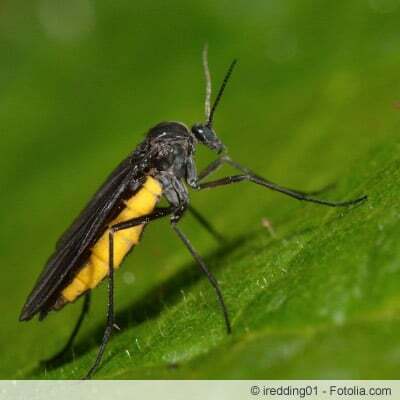
But if a few females stayed behind, they would still produce offspring. The more females you stop laying eggs, the smaller the next generation will be... and you can come along too achieve resounding success with simple means if you do not tolerate the swarming, but counteract it immediately proceed:
- Put the yellow stickers in the soil of the indoor plants
- Distribute more yellow boards in the room
- Z B. on lamps, the animals are attracted to the light
- Ready-made yellow stickers are available in garden centers and hardware stores
- Making yellow boards yourself saves a lot of money in the long run
- Water indoor plants sparingly
- Only water indoor plants from below (over the saucer).
- Do not leave water in the coaster for a long time
- Store potting soil in a cool, dry place
- Seal opened bags airtight
- Apply sand to potting soil in 3 cm layers
- Pour a 3 cm layer of sand into coasters
- Vogelsand (without lime), chinchilla sand, fine quartz sand are suitable
- Finely ground nutmeg contains insecticidal myristic acid
- Scatter evenly over the potting soil
- Carnivorous plants also eat fungus gnats
Several plant protection products containing neem are also approved for home and garden use against fungus gnats, and you can even do that Neem oil, which is still lying around in the cupboard because it wasn't effective enough against house dust mites, diluted with water around the plants spray.
With all these measures, you make it really difficult for "mother fungus gnat" to lay her eggs. She will make an effort and still make it (how many things one does for the children), albeit to a much lesser extent. Therefore, once fungus gnats have been sighted in a household for the first time, the program described above remains a permanent one. Sand and co. also have a preventive effect against fungus gnats, and there should always be one or two yellow boards somewhere between plants - so you can add more when the fungus gnat infestation increases emerging.
For the normal household, in which nobody breaks out in hysteria if an insect is occasionally seen, these simple measures are completely sufficient. You don't need to buy nematodes or go catching predatory, swamp or dancing flies, just make sure that the fungus gnats don't get the upper hand. By the way, if you don't kill every incoming insect immediately, these visitors will help you with that.
If you have started breeding rare exotic plants, a horde of tender lettuce plants still very much grows small towards planting out or the fungus gnats have hijacked your greenhouse, things can be different look; then you might want to clear the area of sciarid gnats. This is possible and is described in the article "Fighting sciarid gnat larvae", but it causes considerably more effort. b. parasitic nematodes and predatory mites from the trade are used.
For the normal household, however, it is even advantageous to add the fungus gnats to your own cycle, as in the cycle of nature household (which is quite similar to a natural cycle and similarly good for people who act thoughtfully functions). Fungus gnats usually do not harm the plants as a whole, the larvae also feed on organic waste, fungus gnats are among the most important decomposers of organic residues. And they also feed on fungal mycelia, which are always a problem in potting soil; the fungus gnats in the flower pot improve the soil and prevent excessive fungal infestation.
Better not
Some plant protection products are offered in the commercial sector against fungus gnats, with Pirimiphos-methyl, deltamethrin, magnesium phosphide and more, all dangerous for the environment and toxic to aquatic organisms.
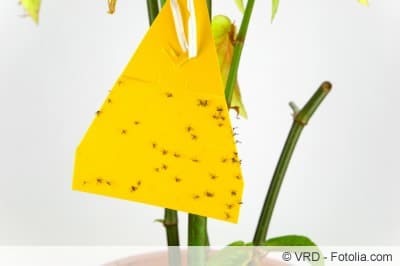
But they are not approved for the house and small garden, it's better that way, they are poisonous when inhaled or cause allergies, irritate the skin and eyes, disturb the endocrine system or explode when in contact with water - and therefore it is better not to follow the tips on how to get such substances illegally approach. Above all, not the tips to use non-approved pesticides in the house and small garden, their Approval has also just been revoked in general, as with Calypso or other plant protection products Thiacloprid (also: www.ndr.de/ratgeber/garten/Insektizide-Gefahr-im-Garten, insecticides102.html ).
The tip to sterilize the soil by heating it up is also not really recommended – you either do that largely dead soil "more dead," or robbing a good soil of the ingredients that make it good (more on that in a moment below). It would then be more consistent to switch to purely mineral (inorganic) substrates in which fungus gnats cannot reproduce. In this whole area, from organic ornamental plant cultivation to alternative substrates to substrate-free cultivation, there are many exciting approaches that you could find out about.
Where do the fungus gnats come from?
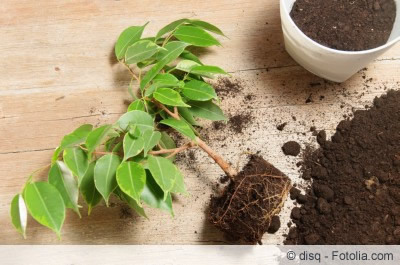
If you are wondering how fungus gnats were able to hatch on you, although you always check houseplants carefully for pests when you buy them and also pay a lot of attention to hygiene:
You'll probably never be able to fathom that exactly. Because the mini-flyers from the family of Dipterans (suborder 1, mosquitoes, suborder 2 are the flies) were extremely successful in evolutionary terms. Around 1,800 species are currently known worldwide (and that's definitely not all of them), 600 of them live in Europe.
Fungus gnats can live pretty much anywhere, on the islands around Antarctica and in hot deserts (where they surviving temperature peaks buried in the desert sands), on mountains over 13,000 feet, on the tundra, and in the dark Caves; but they prefer to live in nice, moist and shady biotopes. So forests and moors, meadows and pastures, fields and well-watered house gardens, maybe with a pond - Germany is a great environment for a fungus gnat anyway.
In these forests and meadows and Co., the fungus gnats live hidden in leaves and plants, but in large numbers: Fungus gnats account for up to 70% of resident mosquitoes in their favorite biotopes (moist and shady). Fly. They are also spreading very well in the rest of the country: the wind and means of transport carry them further, and they are used in new ones when trading in agricultural products, humus, potting soil Species introduced and driven around, greenhouses for growing exotic houseplants are productive with their climate and the lack of enemies Fungus Gnat Breeding Sites.
If there are so many little black dots dancing through the air that you notice them, it's probably not the first generation of fungus gnats flying around. But the second or third generation, which emerged from eggs in the soil of their houseplants.
Since fungus gnats are actually "on the move" everywhere, they may well have gotten into the soil of your houseplants at the dealer. The commercially sold substrates called "potting soil" often no longer contain a colorful one Mixture of industrial and commercial waste, so don't have much to do with soil in the sense of garden soil do.
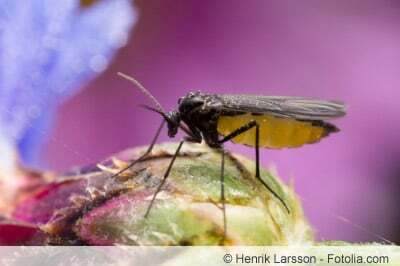
But among the main components that make up a growing medium (for the retailer, for you it's called potting soil and is in the pot of the houseplant) according to Section 4 in connection with plant 2, Table 7 Fertilizer Ordinance may exist, is something that dead organic matter eating fungus gnat larvae certainly do not despise, here are probably the "tastiest" Examples:
- 7.1. Vegetable substances: peat, moor mud, healing earth without drug residues, vegetable substances from food, luxury food or animal feed production + Agriculture, kitchen and canteen waste, vegetable filter material from biological exhaust air purification, vegetable waste and screenings from the water management
- 7.2. Animal substances: Animal by-products according to Article 9 and 10 of Regulation (EC) No. 1069/2009 such as solid manure, liquid manure, Stomach and intestinal contents and many other nice things that you can read about yourself in the regulation (land in the potting soil e.g. B. who were so regretted in the media, quote from the legal text: "day-old chicks killed for commercial reasons")
- 7.4 Other substances and organisms: sludge from the food industry, from milk processing effluent, Beverage production, gelatine production, production of plant-based food and beverages, sewage sludge, organic waste from your Bio bin... etc.
All of these substances, while no longer identifiable in store-bought potting soil, can actually make their way into your home; it is therefore no wonder that fungus gnats also appear in houses and apartments and develop there in flower pots.
If imported houseplants are sold in this potting soil, then they may also be imported fungus gnats - which don't survive German winters outside, but our room temperatures are great find. Gardeners who have already dealt with the composition of commercially available growing media mix their own potting soil from garden soil, compost and, if necessary, loosening components. In good garden soil and compost there are natural antibiotics and microorganisms that do not give fungus gnats a chance to multiply…
 garden editorial
garden editorial I write about everything that interests me in my garden.
Learn more about pests

Ants in the raised bed: what to do?
If ants are found in the raised bed, quick action is required. With the right means and measures, however, the insects can be easily controlled or driven away.

Fight vine weevil: 6 home remedies
The vine weevil is only a problem in the garden when it occurs in large numbers. The beetle eats the leaves, the damage to the larvae is much greater. They eat at the roots and can also cause plants to die off.

Big holes in the garden: which animal was it?
Whether in the lawn or "just" in flower beds, holes in the ground make no gardener happy. But who causes the holes? And how do you get rid of them? We explain causes and strategies for annoying visitors underground.

Combat Little Red Spider | 7 tips for garden & balcony
Although the little red spider is harmless because it neither stings nor transmits diseases, its occurrence is still a thorn in the side of many people. The little creatures become particularly annoying when they are not just limited to infesting plants, but also spread out on the balcony or even in the apartment. Fortunately, effective biological measures exist to control the arachnids.

Rats in the garden: what to do? How to fight the plague of rats
Many people are disgusted just at the thought of rats: after all, the harmful rodents have been considered carriers of dangerous diseases for thousands of years. The animals also cause considerable damage in the house and in the garden. This is how you get rid of the plague again - sustainably and effectively.

Ultrasonic Rat Control – Does Ultrasound Help Against Pests?
Rats in the house or in the garden are not only disgusting, they can also quickly become a problem. But what can you do about it? Ultrasonic rat control is often recommended. However, the method is very controversial. More about this is here.
